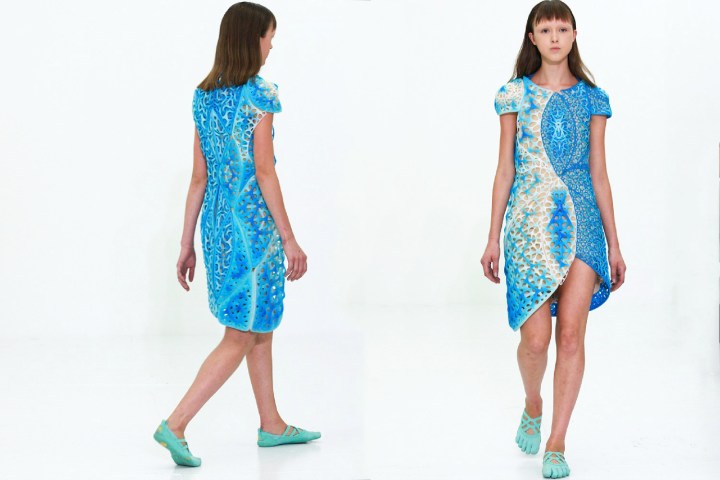
Dubbed ‘Oscillation’, the design was the centerpiece of the avant-garde studio’s Quantum Vibrations collection.
“We got very interested in the geometric shapes which lie beneath vibration,” designer Gabi Asfour told Digital Trends. “We spent a long time researching them and discovered that there are very specific formations that happen under certain frequencies. These formations reminded us of prints and other designs, a bit like tribal tattoos.”
The dress itself was created in collaboration with regular threeASFOUR partner designer Travis Fitch, along with 3D-printing company Stratasys. It is composed of 30 separate multi-material, multi-color 3D-printed parts, assembled from 270 design files.
“We approach 3D printing as a source of tactile fabrics of the future, which can have some very special properties,” Asfour said, explaining his appreciation of additive manufacturing. “For example, we see the possibility of materials that are heat resistant or cooling, things like that. Right now, we’re still at the start of that journey — and what interests me is the possibility of different interlocking weaves that would not be possible to achieve in any other way. The same is true of the shapes you can achieve compared to traditional fashion cutting methods. 3D printing is both function and form.”
And while you probably will not be able to buy Oscillation anytime soon to wear to your office party, Asfour said 3D printing is definitely going to be finding its way to high-street fashion before long.
“I think of it as being similar to the fabric lycra,” he said. “When lycra first appeared, it wasn’t necessarily used for runway fashion, but it was used for professional athletics. Later on, it began to filter down to the high-street level. Lycra has changed the fashion world immensely. The way I see 3D printing is along those same lines. I think it’s going to alter the fashion industry enormously — and in ways we can’t even start to imagine yet.”
In other words, you could say, the vibrations are just starting to be felt. Pun intended.
Editors' Recommendations
- 3D printed cheesecake? Inside the culinary quest to make a Star Trek food replicator
- AMD’s revolutionary 3D V-Cache chip could launch very soon
- Fighting football injuries with 3D-printed, hyper-personalized pads
- NASA is testing a 3D printer that uses moon dust to print in space
- The best 3D printers under $500


